Princeton, Lyman Spitzer Jr. *38, and Astronomy
After A Brilliant Record, New Vistas in the Space Age!
This fine essay continues a series of articles we have been presenting on the history and prospects of the sciences at Princeton, together with some non-technical description of what each science is “about.” If it were not for its Prospect Street location, the Astronomy Department would probably be quite unknown to the average alumnus, and news of the remarkable work the Observatory has been doing and of its training of astronomers will come as a pleasant surprise, as well as the fact that its Director, Henry Norris Russell ’97, in addition to his unique undergraduate degree INSIGNI CUM LAUDE, was “the outstanding U.S. astronomer in this century.” As this article describes, his spirit goes marching on in the persons of Professors Spitzer, Schwarzschild and their colleagues – among them the author, who took his Ph.D. here in 1955 and is now Assistant Professor. – Editor (1962)
The Observatory of Instruction, near the corner of Washington Road and Prospect Avenue, is familiar to many alumni as the “’Scope and Come Club” – a rambling frame structure which houses a small telescope (under the dome), offices, and, in the far end of the building, living quarter for the Director, Dr. Lyman Spitzer Jr. While the number of departmental students over the years has been small, hundreds of undergraduates have taken Professor John Q. Stewart’s ’15 course in General Astronomy – a long-time favorite.
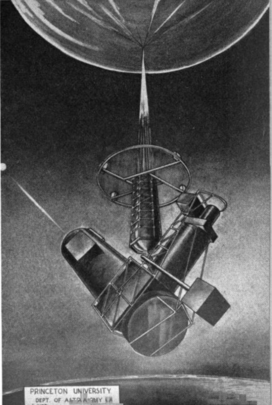
There are those who consider the Observatory on Prospect Avenue an inspiring relic of the Victorian era. Built in 1877 to house the first Director, Professor Charles A. Young of Dartmouth, it emanates a scholarly charm reminiscent of the days when astronomers could pursue their recondite researches remote from the hurly-burly of the world. Professor Henry Norris Russell ’97, the second Director, was moved to remark in 1927 that “the occupancy of the present Observatory of Instruction…is perhaps the greatest single asset which the Observatory possesses.” A modest appraisal, for clearly such an asset was Professor Russell himself.
Professor Russell presided as Director from 1912 to 1947, his tenure surpassing Young’s by seven years. In between, Professor E. O. Lovett was Professor at the Observatory for a few years before he was called to be the first President of Rice Institute. As Professor Spitzer took over in 1947, the Observatory has had only four Directors in its 84 years. Those Directors provide clues as to the changes in astronomical research over that period. While Young was primarily an observer, whose patient research had led to an improved list of important features in the spectrum of the sun, Russell brought to the Observatory (where he had been Young’s student) a consuming interest in the reasons for observed phenomena. Armed with physics and mathematics, he sought to explain the features of stars which were being elaborated by astronomers around the world. Thus, while Young had been content to describe and measure the spectral features, Russell was eager to know what caused them. Were atoms responsible? If so, which, how many, under what conditions?
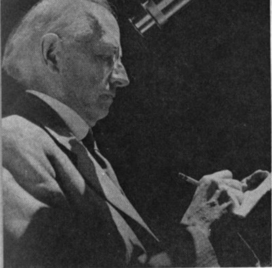
Such inquires led Russell straight into the mysteries of atomic physics, a subject which at that time was being rapidly developed by the physicists. It appeared that the wave lengths (colors) of emitted light were fixed by the atoms (elements) emitting them, and by the configurations of electrons within those atoms. In 1925, Russell and a co-worker, F. A. Saunders, described a regularity they had found in these wave lengths, and a physical explanation for it which today is discussed in advanced physics texts under the heading, “Russell-Saunders Coupling.” Such researches were often pursued in collaboration with University scientists such as Professor Allen G. Shenstone ’14 of the Physics Department.
Russell’s Great Discovery
On the other hand, Russell brought his powers of reasoning equally well to bear on observed regularities in the characteristics of stars, particularly on the correlation of the color of a star with its brightness. If we make a diagram of color and brightness, placing each star at a point indicated by the measurements, we might expect a random scatter of points. Instead, Russell (and at about the same time Hertzsprung) discovered that the stars fall in very narrow bands. This was later explained on physical principles – given the brightness of a star, one can predict its color. Moreover, it was found that a star can move from one area on the diagram to another with the passage of time, so the diagram can be used to study the evolution of stellar groups; hence Russell’s discovery is a touchstone for modern astrophysics.
Today we know that these sequences have a profound physical meaning (which we shall discuss further on). Doubtless it was this discovery (along with dozens of others) which led Fortune Magazine to remark in a recent article on astronomers, “Russell…is considered by many to be the outstanding U.S. astronomer of this century.” The same article, incidentally, chose two of the eight representative outstanding U.S. astronomers from the Princeton group – Schwarzschild and Strömgren. An additional one, Shapley, was a Princeton Ph.D.
Russell is therefore properly called an astrophysicist, one who seeks to explain the regularities in astronomical data by application of physical laws. Along with his contemporaries such as Eddington and Milne in England and Karl Schwarzschild in Germany, he laid the foundations on which modern astrophysics is based. Now, of course, astrophysics is an important branch of astronomy, along with astrometry (finding the positions of stars), photometry (brightness-determination), radio astronomy (detection of radio emission), spectroscopy (study of features at certain wave lengths), etc. One discerns two approaches to astrophysics (as to most branches of science) – the experimental and the theoretical, but every possible combination of the two in the makeup of individual astrophysicists may be found. Thus, while one man may be using the laws of mathematics and physics to explore a phenomenon from the theoretical side, another may be using the tools of photometry and spectroscopy to observe an actual example in the sky. Such is the case for the problem of the eclipsing variables.

These stars are observed to vary in brightness in a regular fashion. Long ago they were properly explained as due to the orbital motion of two stars around one another, accompanied by periodic eclipses when the fainter star obscures the light of the brighter.
Princeton played an important part in the study of these stars, both on the observational and theoretical sides. R. S. Dugan, a colleague of Russell, made thousands of observations of their light-variations; Russell got interested in the mathematics and computed tables giving the relationship between observed quantities, such as fraction of time spent in eclipse, and interesting properties of the system, such as the ratio of the stellar diameters, the orientation of the orbit, etc. Together the two sides of the problem were joined in the Ph.D. thesis of Harlow Shapley, who took his degree at Princeton under Russell in 1913, and went on to become one of the leading astronomers of our time, and Director of the Harvard Observatory. (His successor at Harvard, Donald H. Menzel, was also a Princeton Ph.D.)
The Successor to Russell
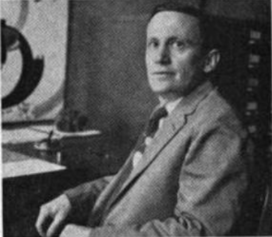
When Professor Russell retired in 1947 he was anxious that the new Director should be a young astrophysicist who could build well on the foundations he had laid. A natural choice was found in Lyman Spitzer, Ph.D. ’38, who as a student of Russell’s had done theoretical work on the atmospheres of very extended stars. He was appointed Director of the Observatory at the age of 33, and later Charles A. Young Professor of Astronomy on the Class of 1897 Foundation. Along with him came Dr. Martin Schwarzschild, 35-year-old son of the famous Karl Schwarzschild. In the company of Professor Stewart, here since 1921 and an outstanding exponent of the application of physical reasoning in discovering the laws of society, and Professor Newton L. Pierce, an expert observer of double stars, they undertook to continue Princeton’s tradition in astrophysics.
Spitzer’s and Schwarzschild’s interests on the face of it are very different. Spitzer has made pioneering calculations concerning the temperature of the very rare gases lying in interstellar space, under conditions where an atom might hit another atom or absorb some light once per year. Schwarzschild has been concerned with the interior of stars, where such collisions and absorptions occur every billionth of a second. Yet the two lines of thought are joined when one considers that in all likelihood, the myriads of stars which make up the Milky Way galaxy at one time did not exist, and the gas density was one hundred times larger than it is now. Then as the eons have spun by, the gas has progressively condensed into stars, forming populations of different ages. The more massive among the stars bur their nuclear fuel so rapidly that a core of “ashes” – helium atoms – develops at the center of the star. In consequence the star is forced to readjust its outer layers to conform to the profound changes within, and the star changes its position in the Hertzsprung-Russell diagram. By careful calculation, using electronic calculators with the assistance of Mr. Richard Härm, a skillful computer, Professor Schwarzschild has been able to find the age of a star corresponding to a given present position in the HR diagram, and so has aided in the identification of different sequences of stars, alluded to above, as groups of stars of various ages. * The very oldest appear to be 20 billion years old, the youngest, perhaps a million years – representing a spread in age of twenty thousand to one. The study of the almost continuous range of varieties in between is closely linked with the history of the Milky Way. Somewhat analogous to the evolutionary picture in geology and biology, it traces the development of the astronomical universe under the action of powerful physical forces.
* See his Structure and Evolution of the Stars (Princeton University Press, 1958.) – Editor (1962).
A Star Is Born
As yet we have only a vague understanding of these forces, but it is in this area where Professor Spitzer’s contributions have been so important. Starting with the interstellar gases under the influence of gravitation, pressure, magnetism and radiation, he has delineated how a balance can be set up in which clouds form in the vast reaches of interstellar space. These clouds become unstable and rush into smaller volumes under gravity; the concentrations so formed condense into stars, rotating ever more slowly under the influence of magnetic forces. Then, curiously, the groups of hot stars react back on the clouds from which they formed, pushing them away by means of their radiation. It appears that the speeds so acquired by the clouds may be important in prolonging the life of the galaxy, because they tend to oppose the slowly-acting forces of gravitation which would cause further star-formation. Over the past twenty years, Professor Spitzer has attacked many facets of the problem of star formation. Known among his colleagues for his physical intuition, he eschews elaborate mathematics but strives instead for clear physical interpretations.
It is gratifying to the younger men who have been influenced by this pair of professors at Princeton (and there are many) that Schwarzschild’s thorough and patient mathematical labors concerning the stellar interior, and Spitzer’s more pictorial, yet poignant considerations concerning the interstellar matter, have converged on this central evolutionary scheme described above. One can well imagine the delightful discussions which occur regularly at the Observatory between these two complementary personalities, as they lead their colleagues toward a more profound understanding of the way nature has worked in creating our starry universe.
Both men are observers as well as theoreticians in perhaps a 50-50 combination. For many years they have used the great telescopes on Mt. Wilson in California. Spitzer has been particularly interested in the interstellar gases. By measuring the amount and color of light which those gases absorb when they lie in front of a distant star, he was able to find out much concerning their composition, distribution, and motion. One of the most curious findings was that the gases seemed to agglomerate in giant clouds, trillions of miles across. As mentioned above, this peculiarity seems intimately connected with the birth of stars – they don’t form just anywhere, but condense in great numbers out of a particularly dense cloud. How wonderful it would be to watch such a cloud for a few hundred million years! Stars would form like raindrops and begin to sparkle in the gloom like jewels against black velvet. Unfortunately, we must be content with “snapshots” of many contemporary systems in the hopes that we can piece together a “motion picture” of this splendid event in nature.

Professor Schwarzschild has worked more on the stars themselves. One of the most interesting discoveries was that certain types of stars (suspected of being older) were strangely lacking in the elements heavier than hydrogen, like carbon and oxygen. If one assumed that all of these heavier elements had formed during the first few minutes of the expansion of the universe, when the required temperatures and pressures were available, there seemed to be no reason why older stars should be deficient. But it became increasingly clear that certain types of stars were so hot at the center that elements could form there; and it was suspected that certain of these stars exploded as supernovae, throwing out the elements so formed into the interstellar medium where they would be drawn into any new stars that formed. In that way the interstellar medium would be increasingly enriched with heavy elements, and older and younger stars would show definite differences in composition.
“Big Bang” vs. “Steady State”
This line of thought received an enormous push from the work of Fred Hoyle, an outstanding English astrophysicist and popularizer of astronomy. With his collaborators he applied nuclear physics to the problem and showed that conditions inside pre-supernova stars would lead to exactly the abundances of various elements which we observe. A regular visitor to Princeton, he collaborated with Schwarzschild on certain aspects of the problem. Curiously enough, he was led to his attempt to explain the formation of elements in stars because he did not accept the “big bang” picture of the universe, according to which matter on the largest scale is constantly expanding and, looking backward in time, was once compressed into such a state that element-formation was possible. Rather, he had speculated that the universe was in a continuous steady-state, the matter disappearing in the form of receding galaxies being replenished by spontaneous creation of hydrogen in intergalactic space.
In this view, of course, it was necessary that heavy elements be formed in stars, intergalactic space being far too cold. Recent data from radio astronomy, optical astronomy, and gamma-ray astronomy seem to indicate that the universe cannot be in a steady state and that some version of the “big bang” is applicable. Of course, this does not vitiate the work on element-formation in stars; it only appears that he was led to a new concept by a hypothesis which may be wrong. We owe him a great debt, even if the universe is not entirely “according to Hoyle.”
Space Astronomy

When Spitzer came in 1947 he remarked that the only eventuality he could imagine drawing him away from Princeton would be the opportunity to construct an observatory to orbit the earth in an artificial satellite! This remark, made ten years before Sputnik, has proved to be prophetic, for the feasibility of constructing such an observatory is now accepted. A group assembled at Princeton by Dr. Spitzer is now designing a 30-inch telescope to be launched into orbit in 1965.
Dr. Spitzer goes so far as to predict that ultimately very large telescopes will be built in space orbiting the earth. He reasons that the limitations on detecting faint objects are now imposed by the atmosphere. As it is technically possible to construct a large telescope in orbit, this limitation can be avoided. Among other problems which could be studied is the question of the ultimate dimensions of the universe. While it was hoped that the 200-inch telescope on Mt. Palmar might solve that question, great difficulty has been experienced in detecting the most distant objects. A satellite observatory might succeed, by avoiding atmospheric interference.
The Balloon-Borne Telescope
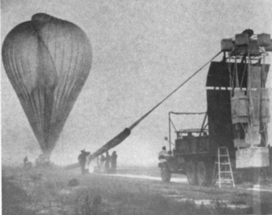
While Spitzer had been enthusiastic about space research as far back as 1946, when he pondered the great advantages accruing to a 600-inch telescope in orbit, it was for Schwarzschild to actually make the first leap into space. One day Dr. James Van Allen, who was later to discover the radiation belts of the earth using the first U.S. artificial satellite, remarked at lunch to Spitzer and Schwarzschild – “You astronomers are too conservative. We physicists have been using balloons for years to hoist scientific instruments into the stratosphere. Surely you have problems which could be solved by this technique.”
Well, it happened that Schwarzschild had exactly such a problem in mind. One of the major uncertainties concerning the interior of the sun is the efficiency with which convection – the gross vertical motion of the solar material under the influence of heating from below – carries energy to the outer layers. One reason for the uncertainty is the difficulty of observing the finer details of the resulting pattern of motions on the solar surface. By a curious coincidence, the very same process in our own atmosphere disturbs the optical image of any object observed with a telescope with the result that the stars appear to twinkle, and the delicate patterns on the sun blur out. Would it be possible, thought Schwarzschild, to observe from above the atmosphere and thereby get the necessary clear pictures of the sun?
With characteristic determination he pushed ahead, and the final result was Stratoscope I – a 12-inch telescope carried to 80,000-foot altitude by a giant balloon in the summer of 1957. A number of superb photographs were obtained, helping to settle many questions concerning the pattern of motions. Dr. John Rogerson collaborated on this project. Later in 1959 a much improved device was flown by an enlarged group including Dr. John Bahng and Dr. Robert Danielson; whole time-sequences of sharp pictures were obtained.
By now Princeton Observatory alone embodies some aspects of the international “Space Race.” Not only is Spitzer pushing ahead with his plans for a satellite, but Schwarzschild hopes to launch a much larger telescope, Stratoscope II, to photograph much fainter objects than the sun.
Both techniques get above the atmosphere, but the undesirable atmospheric effects thereby mitigated are different in the two cases. A balloon-borne instrument in the stratosphere is above 96% of the atmosphere, and the expected absence of the twinkling phenomenon has been proven by the Stratoscope I pictures. Now it is desirable to apply the principle to fainter astronomical bodies, such as the moon, planets, star-clouds, and galaxies. Such an enterprise demands a 36-inch telescope built to track the stars with great precision. The presently-contemplated 1/10 second of arc represents an accuracy in pointing the telescope equal to one part in two million. Can this be done by remote control from a moving balloon 15 miles up? Present-day engineering experience answers, “yes,” and we look forward eagerly to the first results of this project in a year or two.
A Satellite Observatory in Space
The satellite is designed primarily to get above the ozone layer, which extends to some 30 or 40 miles – beyond the reach of the balloon technique. The ozone absorbs ultraviolet light strongly. It is a great boon to mankind, who would be seriously burned by the solar ultraviolet rays were it not there, but a hindrance to the astrophysicist who needs all the radiation he can collect to obtain clues to the composition and structure of the heavens. Thus Spitzer has calculated that we should be able to observe many constituents of the interstellar gases by their effects in the ultraviolet. For example, hydrogen gas is known to be present in the form of atoms, judging by certain radio waves they emit. But no one knows how much is present in the form of molecules, because these do not emit or absorb either ordinary light or radio waves. In the ultraviolet there should be clear-cut indications at predictable wave lengths of its presence or absence. If the test should be affirmative we may find we have missed a large fraction (even as much as 90%) of the interstellar gases in our previous considerations. The far-reaching implications of such a discovery are clear. Therefore we are quite excited about the experiments which this group, including Dr. Rogerson, Dr. Kurt Dressler, and Dr. Donald Morton, will carry out in the next few years.
The author is interested in the application of ultra-violet techniques to the determination of the mass of the universe. Ordinary optical methods lead to an estimate of the amount of matter in galaxies – the billions of “island universes” each containing about 100 billion stars, out of which the observed universe is formed. For example, the mass of our own galaxy (which appears to us as the Milky Way) has been determined to be 200 billion times that of the sun. Now the galaxies appear to be receding from us in a systematic way, by amounts ranging up to half the velocity of light for the most distant ones. This so-called “expanding universe” is of great interest because it seems to imply that after a long enough time the universe will be increasingly empty, and we will be left all alone with our Milky Way.
But certain observations suggest that the expansion is being slowed down by a gravitational force, just as a rocket is drawn back to the earth. What is the source of this force? Our estimates of the mass of galaxies indicate that they fail by a factor of one hundred to account for the effect, hence the suspicion is growing that the gravitation due to gases swirling in intergalactic space is responsible. Though perhaps 99% of the universe is in the form of this undifferentiated material, it has never been detected, owing to its being spread over such huge volumes with such low densities.
One possible method to detect it is by its dimming effect on certain radio waves coming from distant galaxies. The author has carried out an experiment of this sort using the 85-foot radio telescope at the National Radio Astronomy Observatory at Green Bank, West Virginia, together with an extremely sensitive radio receiver. No effect was found, and from this we may conclude that material in the required amounts must be in the ionized form, in which it cannot absorb radio waves. Ultraviolet light is much more suitable for detecting ionized gases, and we may hope to settle this problem by that means. If it turns out that the matter is there, and the gravitational force great enough to pull back the galaxies before they escape, we must contemplate future eons when the “expanding universe” becomes the “contracting universe.” The state of mind of the astronomers of the future, on discovering that billions of galaxies are rushing at them with enormous velocities, will doubtless be somewhat disquieting. The least we can do is to warn them!
A Universal Space Platform
It is easy to imagine that the orbiting astronomical observatory embodying a 30-inch telescope is not a simple enterprise. NASA is developing a general-purpose “space platform” which will serve as an oriented and stabilized base for various astronomical instruments, including Princeton’s. In the meantime, the Princeton group plans a series of rocket flights with similar equipment which will permit brief observing of the same kind they will do later on a daily basis. These suborbital flights are scheduled for next year. Thus the Princeton balloon and satellite groups are conducting their own private space race, leapfrogging ahead of one another in scientific achievement. It is gratifying that no matter what happens, Princeton Observatory wins!
The Observatory utilizes a novel method in developing the new equipment needed for space astronomy. Rather than hire dozens of engineers and technicians, the University contracts for the work with private industry. Thus, the Perkin-Elmer Corporation is building the 36” reflector for Stratoscope II. The largest mirror ever made of fused quartz, it will be fabricated with a precision never before attained – one millionth of an inch. The Vitro Corporation is charged with developing the new balloon system needed to hoist the telescope into the stratosphere; its 6,300-pounds will be the largest payload ever lifted by a balloon. RCA is designing a new television system for transmitting pictures to the ground station to give the astronomer the information necessary to operate the telescope by remote control. Obviously formidable engineering problems are being encountered in all phases of this work. By contracting it out, the staff at the Observatory can concentrate on the astronomical objectives of the program, and by now a fat file of sky-targets has been evaluated; at the same time, the highest grade engineering talent has been recruited in industry to construct the telescope.
The Enormous Cost
The cost of these projects is enormous. Several million dollars are being supplied by the Federal Government through the Office of Naval Research, the National Science Foundation, and the National Aeronautics and Space Administration. In spite of this vast increment in spending, the Observatory has managed to get along with only a modest increase in staff. Drawn from diverse backgrounds and usually young men, the new staff members enrich the Observatory in all sorts of directions.
For example, as a by-product of the satellite program, Dr. Kurt Dressler has undertaken observations from the ground with a device similar to the one which will be used on the satellite. Using the 23-inch telescope of the New Observatory (located near Palmer Stadium), he is studying very weak features in the spectra of stars caused by interstellar gas clouds. Both graduate students and undergraduate departmental students participate in this program. Thus the New Observatory has been brought to life again after a brief hiatus during which Princeton astronomers used the telescopes on Mt. Wilson. The New Observatory, built in 1932 to house the 23-inch telescope formerly mounted in the Halsted Observatory on University Place, cost $100,000 of University funds. At that time such an expenditure was a munificent sum, although telescopes always had been the most expensive instrument found on college campuses. Now machines such as accelerators and rockets cost far more, and government help is needed.
Nevertheless, there is still a critical need for private philanthropy in areas that Federal funds can’t reach, as well as in the provision of permanent physical facilities. Mr. Bernard Peyton ’17 has been outstanding in this regard. In addition to providing a 4-inch telescope, he has generously supported the research program at the Observatory; in particular he has established an advanced graduate fellowship which has enable the Observatory over the years to draw the highest-caliber young researchers from all over the world. It is becoming clear that the greatly increased volume of research at Princeton stemming from space astronomy will require support beyond the Federal funds which are limited to specific research programs for a limited period.
The Plasma Physics Laboratory
While not properly part of the Observatory, mention should be made here of Dr. Spitzer’s Plasma Physics Laboratory. Back in 1951 Dr. Spitzer conceived of a possible method of controlling thermonuclear reactions in the laboratory (according to legend, this occurred while he was on a ski-lift in Aspen). Out of this grew Project Matterhorn, an attempt to build a series of test “Stellarators” which would culminate in a device to generate power from the heavy hydrogen found in sea water. As is well known, this and many other similar attempts along different lines have met great difficulties, and as yet the technique has not borne fruit. Most attempts involve magnetic confinement of a plasma. In order to understand the processes which occur in the plasma, a gas so hot that its atoms are torn into their constituent nuclei and electrons, a whole new domain of physics has developed. Of course it is no accident that an understanding of plasma physics is vital to many problems in astrophysics, as indeed the matter in space is often found in the plasma state. The direct gains to the Observatory have therefore been great, both through the deepening of Dr. Spitzer’s understanding resulting from his work as Director of Project Matterhorn (now the Plasma Physics Laboratory), but also by the influx of skillful physicists who have been brought into the Observatory teaching program.
Professor Edward Frieman, who heads the Theoretical Division of the Plasma Physics Laboratory, has from time to time continued his studies in astronomy since his early work in nuclear physics, which is basic to understanding the structure of the interior of the sun. Turning from the dense state of interstellar matter found there he has shown how astronomers can explain certain features of interstellar matter which bear the name “elephant-trunk structures.” Professor Martin Kruskal is also a theoretical physicist at the Plasma Laboratory; his association with astronomy dates from the paper he wrote with Schwarzschild on a certain plasma instability which occurs in certain fusion devices. Today Stellarators are constructed to avoid this difficulty, but it appears that a similar process may be operating in the great magnetic regions around sunspots. There it can lead to extremely violent explosions (equivalent to millions of megatons of TNT) called “flares.” Such flares emit dangerous radiations which are stopped by the earth’s atmosphere, but which would be dangerous to a space traveler. Sophisticated astronauts would be well-advised to consult the Kruskal and Schwarzschild paper! Presently, Kruskal lectures in the Department on the application of plasma physics to astronomy.
What about teaching at the Observatory? Ever since 1947 an average of two graduate students have begun their studies each year. The objective is to fling them directly into research by a series of projects in which they are guided by faculty members. In this way research becomes a natural pursuit, and there is little danger that a student will take refuge from this challenging occupation by the oft-used device of taking more and more courses. Naturally, a balanced program of course work is maintained. One of the most vital activities is the series of seminars and colloquia which occur every Wednesday afternoon throughout the year. The staff usually meets for lunch on Wednesday with the speaker, and often discussions start at that time which continue throughout the afternoon in and out of Observatory offices up until tea-time. At that point, everyone including the students meets at tea and discussion continues. By the time the seminar begins in late afternoon, everyone who is interested will have become acquainted with the subject of the seminar, and the questions following the talk are likely to be very much to the point.
The Undergraduate Program
The whole process is even more activated by a group of astrophysicists who regularly come over from the Institute for Advanced Study, Dr. Bengt Strömgren, an outstanding astronomer, who like Schwarzschild also happens to be an astronomer’s son, was appointed Professor at the Institute in 1957, the first astronomer to hold such a post. His own broad experience, together with the youthful enthusiasm of the three or four younger researchers usually visiting him at any time, are a great asset to astronomy at Princeton. Thus the course work, seminars, guided research, and the availability of expert advice on a broad range of astronomical topics combine to make graduate education effective. As throughout the Graduate School, the emphasis is on frequent student-faculty consultation and on maintaining the highest level of discussion.
What of the undergraduate program? Until very recently, there has been little interest in majoring in astronomy. With the advent of greatly increased opportunities in astronomy as a career, however, steps have been taken to encourage upper-class concentration. At present about the same activity is anticipated as in the graduate program – two new students per year. Four courses are offered, and independent work may be with the 23-inch telescope, or with the balloon or satellite groups, or on a theoretical problem. Again the emphasis is on astrophysics, so it is anticipated that students will take all but the most specialized physics courses taken by physics majors. In this way the students will be prepared to pursue careers related to physics, as well as to astronomy.
Astronomy 301 and 302, General Astronomy and Elementary Astrophysics, and Stellar Astronomy, continue to be by far the most popular undergraduate courses. They aim to bring students to an appreciation of the cultural impact of astronomy throughout history. Remarkably enough, these courses have been taught without sensible interruption for 85 years, by only three men: Young, Russell and John Q. Stewart ’15. Professor Stewart continues to pursue his studies of the application of physics to social phenomena, which has found applications in such diverse fields as telephone engineering and college admissions practices.
It appears, then, that Professor Russell’s goals are being realized, and that the Princeton Observatory is playing an important role in developing astrophysics in the United States. While we are by no means the largest Observatory (Harvard has perhaps five times the number of students) it is generally regarded as an excellent one. Both Professors Spitzer and Schwarzschild have been Henry Norris Russell Lecturers, the highest recognition given by the American Astronomical Society, and have been awarded numerous other distinctions. At present, Professor Spitzer is President of the American Astronomical Society. The number of applications to the Graduate School in astronomy has climbed to the point that only one in five was admitted last year. There is increased interest among the undergraduates. There is even talk of a new building to house the Observatory. While the “’Scope and Dome” may soon be obliterated by nearby construction projects, alumni may be assured that this will only mean that at long last, the physical facilities of the Observatory are being streamlined in keeping with the forward-looking program that has been pursued at Princeton since 1947.
If and when the Department moves to a new building, it is planned to transfer the Rittenhouse Orrery there from its present location in Firestone Library, where many alumni have seen this remarkable instrument, constructed in 1771 to demonstrate the motions of the planets. Found in 1948 by Professor Newton L. Pierce and restored through the generosity of Mr. Peyton, the Orrery will provide a fitting link to the past for an Observatory looking to the future.
This was originally published in the January 12, 1962 issue of PAW.

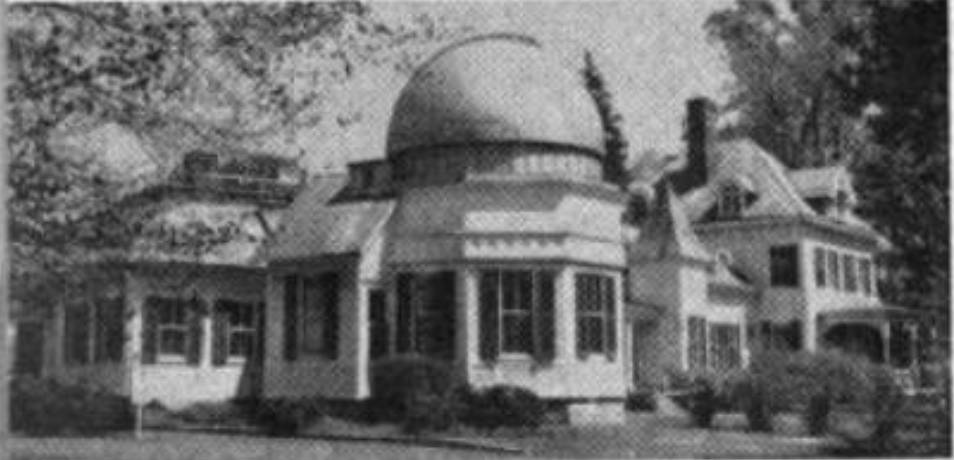

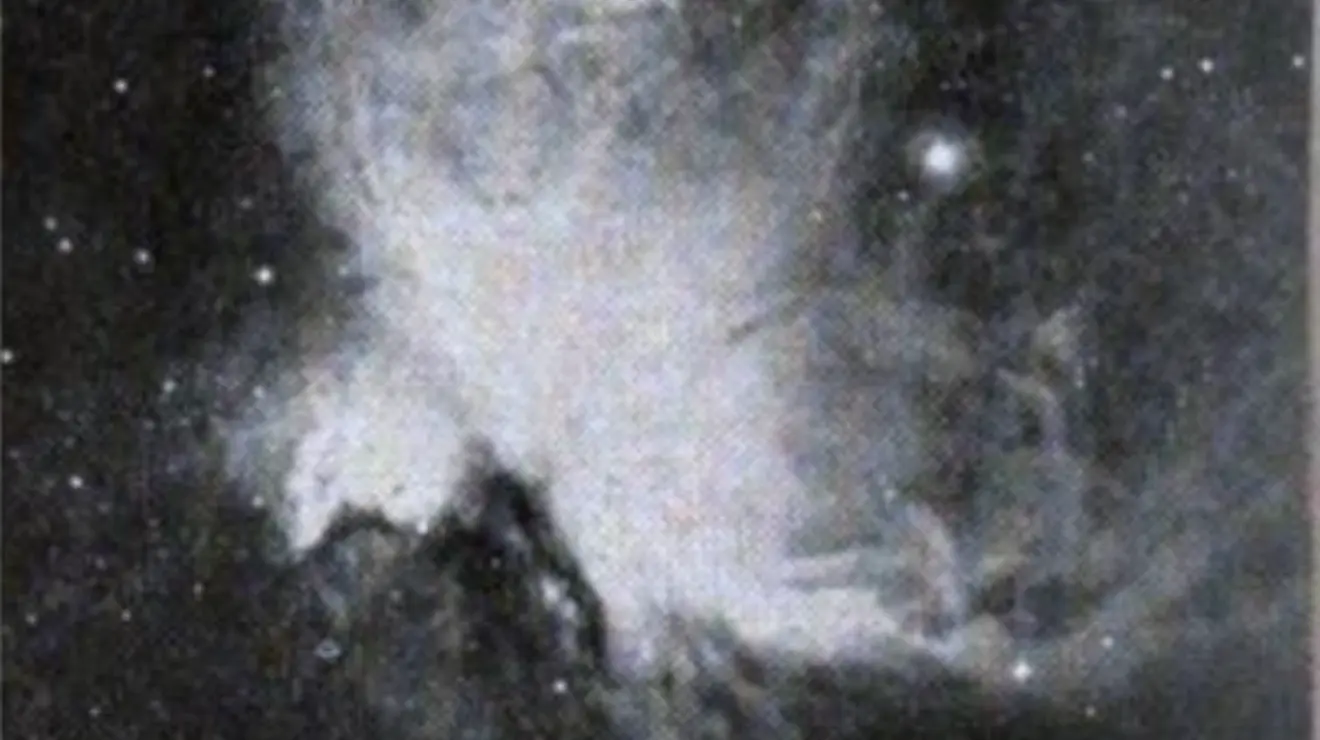
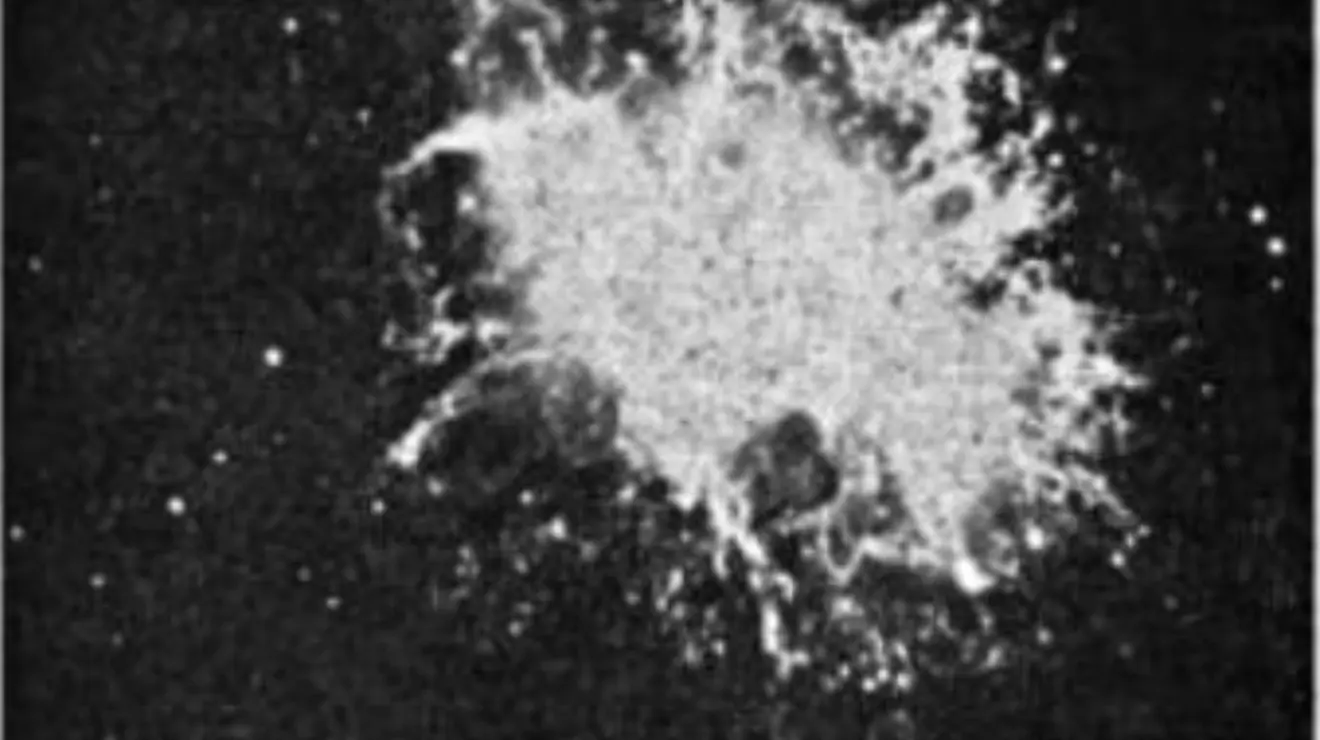
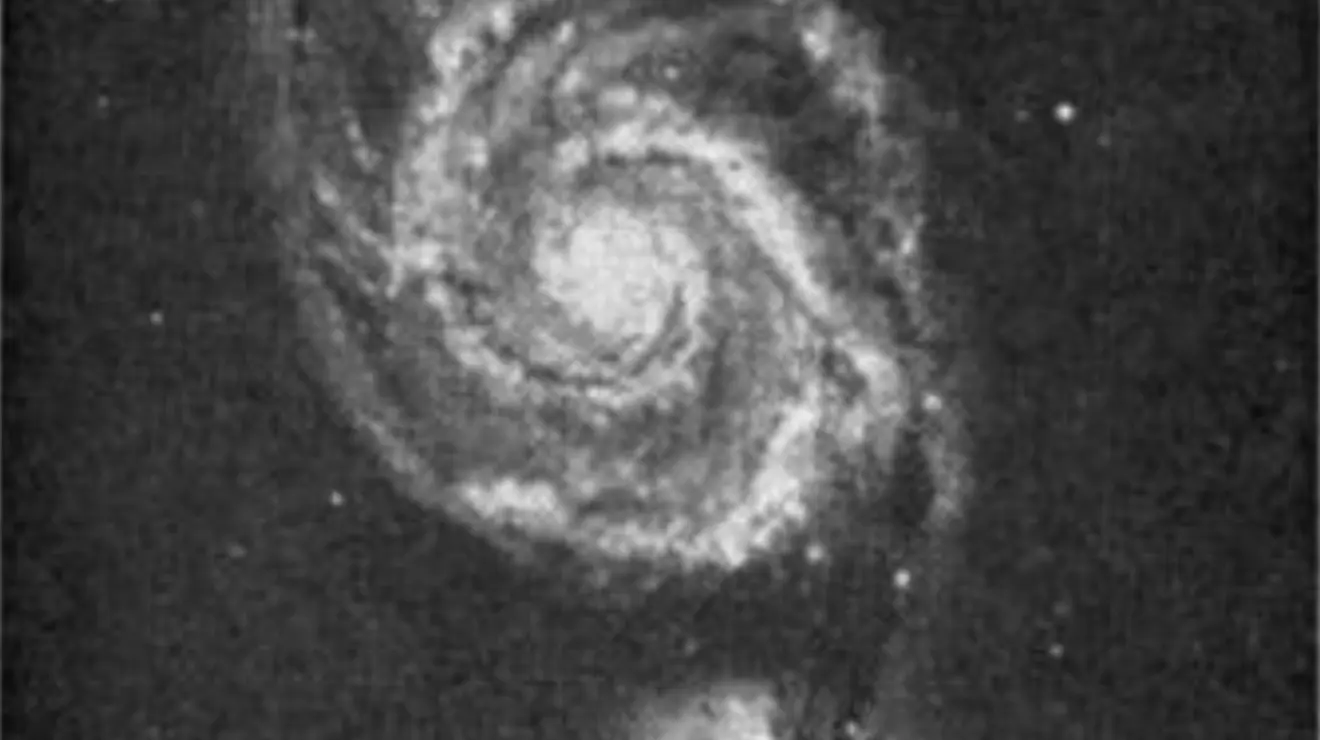

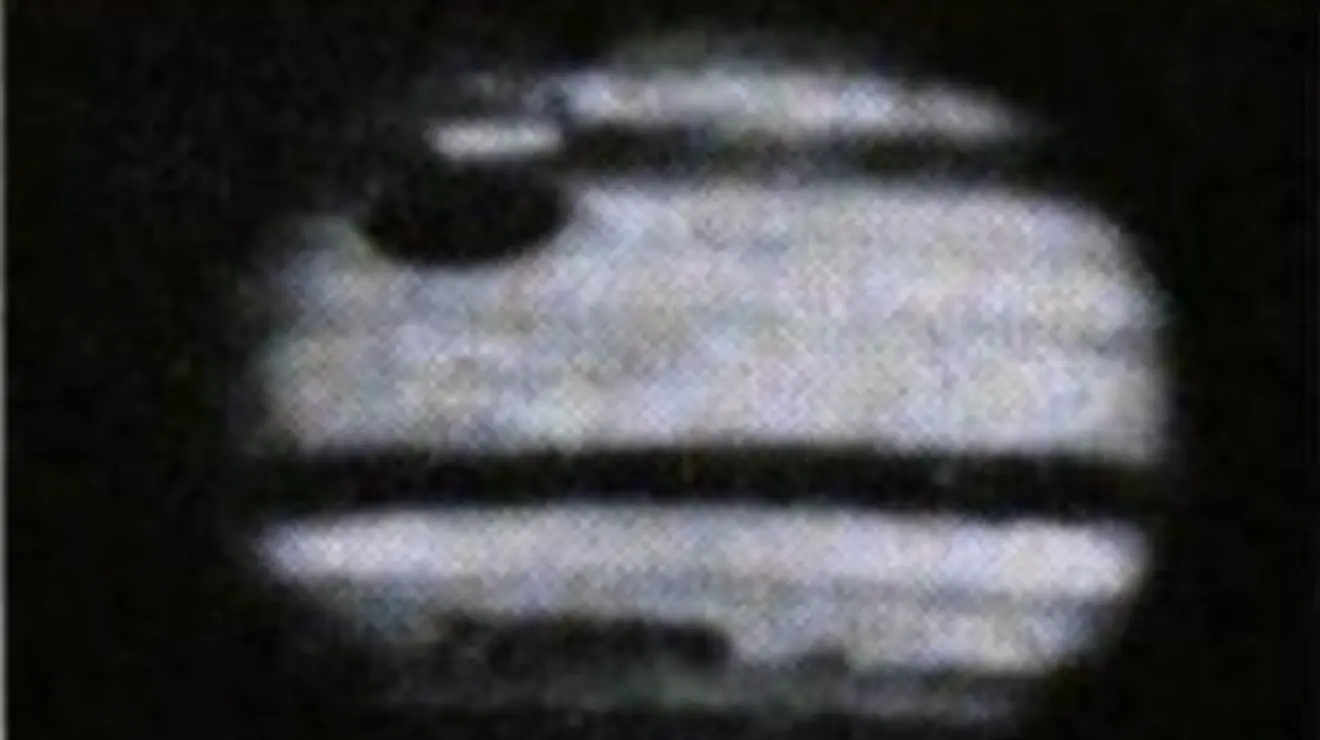










No responses yet